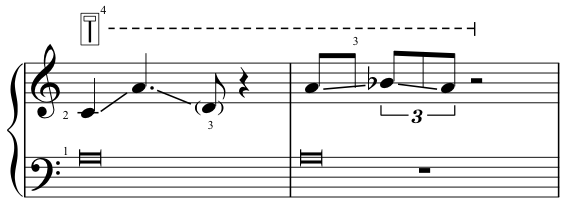Tuning key slide (sons fluides)
Only the metal tuning key is suitable for the following effect. Instead of a metal tuning key a screwdriver with a relatively thick "shaft", a thick percussion triangle beater, or a cylindrical metal object can be used.
Production
The metal part of the tuning key is held horizontally and pressed against the string with one hand. When it is pressed against the string, the string is shortened and therefore its pitch will be higher. The other hand plucks the lower part of the string. As the string is plucked the tuning key is moved up or down. A sliding sound is thus produced between two or more pitches on the same string. The clarity of the sound depends on the pressure of the tuning key and on the material and size of the tuning key or other sliding object. The surface of the object should be smooth, and the object should not have too small a diameter. However, it is important that the diameter is small enough that the object can be easily inserted between the strings without making a noise.
The tuning key can be used to slide between several different pitches on the same string.
Sound
The sound of a tuning key slide is relatively loud and carries well. The sliding effect is very fluid and varies according to the speed of the slide. See: jet sound. The sound can be compared to that of a guitar slide.
Notation
When notating a tuning key slide with exact pitches the following aspects must be indicated:
1. The string on which the sliding should be executed.
An open square indicates on what string the slide is played. However, if it is not important to the composition on what string the sliding is done, it can also be left to the harpist to find the best sounding string. In that case the open square can be left out of the notation.
2. The pitch on which the slide begins and the pitch on which it ends.
The pitches of the slide are notated where they sound.
3. Which notes are plucked and which are not.
Notes that are not plucked should be placed in parentheses.
If the plucking of the string should occur while the tuning key is sliding, then the pluck is notated with a note beam and without a notehead.
4. The tuning key symbol.

Tuning key glissandi with non-specified pitches should be notated graphically. In this case the starting note indicates the string on which the sliding should be executed. The note is repeated when the string should be re-struck.

It is important to know that after the string has been plucked, the sound fades away relatively quickly. Therefore, the sliding should occur soon after the string has been plucked.
Range
Tuning key slides can be executed on all strings. However, they are most effective on the longer gut strings, that is, in the middle register. In the high register the strings are so short that it is hard to fit the key on the string in order to make a slide. On the wire strings the sound is considerably different, since both the string and the sliding device are made of metal. Furthermore, it is hard to reach the lower strings with both hands. To do so, the harpist must either place the harp down from the shoulder or move the whole body to the left-hand side.
All pitches that are a whole tone above the pitch of the string, including microtones, can be produced on each string. (The tuning key, or the sliding object, is normally too thick to allow the production of pitches that are less than a whole tone higher than the pitch of the string.) The pitches can be controlled quite accurately with the tuning key, thus allowing extremely chromatic melodies otherwise impossible on the harp.